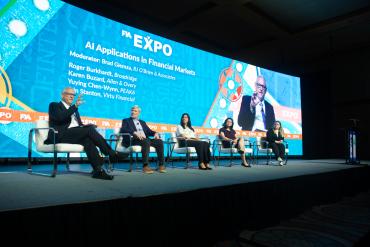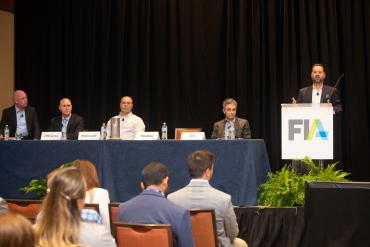The use of artificial intelligence in derivatives markets was a key theme at FIA’s Expo conference on 2 October with speakers sharing how they are exploring potential uses for generative AI as well as demonstrating current applications in trading and clearing.
In the first AI panel of the day, speakers discussed the practical issues that firms should consider as they begin experimenting with generative AI tools and models. Setting the scene, Erin Stanton, global head of analytics client coverage at Virtu Financial, explained the difference between generative AI – or Gen AI – and traditional machine learning.
“Traditional machine learning is what I call ‘discriminative AI’. It looks for patterns and trends within data it is trained on and makes predictions from those patterns,” Stanton said. “Generative AI refers to models or algorithms that create something new. For example, you can use it to help you draft an email. You can use it to ideate on a marketing slogan, or you can use it to help you generate Python code. Discriminative AI is looking for patterns in data, generative AI is more creative.”
Roger Burkhardt, capital markets chief technology officer at Broadridge, described generative AI – which hit mainstream headlines in late 2022 with the launch of OpenAI’s ChatGPT – as a “breakthrough in the power of AI”.
“Broadridge has been building AI solutions for many years, both in our front-office and back-office systems to provide client capabilities and to help ourselves become more efficient,” he said. “When generative AI came along, it really transformed our approach to AI in terms of executive engagement and in investments.”
“We recognised that this was a big breakthrough in the power of AI, and in the democratisation of AI,” he added. “Similar to how in 1995 the World Wide Web provided us with superpowers in terms of access to data, generative AI provides superpowers in personal productivity and product development. We have taken the view as a firm that we want to learn by doing but in a safe environment.”
In June, Broadridge’s subsidiary LTX launched BondGPT, an application powered by OpenAI GPT-4 that answers bond-related questions and helps traders find liquidity in the sparse world of the corporate bond market.
“With 20 years of experience in building AI models, I tend to think in terms of a six-to-nine-month development cycle, some pretty serious budget, and teams of seven or eight people,” said Burkhardt. “However, when we introduced our first Gen AI models, we used one team in the corporate bond market, and we rolled out a new product to fixed income traders in six weeks, which was a wonderful thing. I'm excited about this. I haven't seen anything quite as smooth or quite as fast for a very long time.”
Karen Buzard, a partner in Allen & Overy’s markets innovation group, talked about how the law firm has begun using Gen AI, describing the capabilities as “revolutionary.”
“As a law firm we were ahead of the pack. We had a markets innovation practice, and we were using machine learning and doc automation for many years. We were then introduced to technology that was based on underlying GPT technology created by OpenAI before OpenAI made any announcements,” Buzard told the audience. “There were a couple of us that stayed up for 48 hours straight, plugging in questions and we could not believe the results we were getting in such a quick fashion after training machine learning for so many years. We realised it was going to be revolutionary.”
At the start of this year, Allen & Overy introduced the AI platform, named Harvey, to its global practice to help its lawyers draft contracts after testing it to generate and access legal content. At the end of that trial, around 3500 of A&O’s lawyers had asked Harvey around 40,000 queries for their day-to-day client work.
While the output needs careful review by an A&O lawyer, Harvey helps to generate insights, recommendations, and predictions based on large volumes of data, enabling lawyers to deliver faster solutions to clients, Buzard said.
All the panellists agreed that the impact of generative AI will grow as companies discover more innovative applications for the technology in their daily business. Stanton, for instance, said Virtu Financial’s use of AI technology is currently for decision support, but she believes the next stage could be in producing action-orientated models.
“We have various distributed AI models that categorize data or make predictions on trading strategies that users should consider. We have had a summer of Gen AI experimentation, but we are in the decision support phase right now,” she said.
“We're not taking huge risks; we're not generating any actions from it. Currently, It's all based on human decisions, but the next iteration of this could be where we move the risk paradigm and start performing actions on it. So, for example, I don’t just show you a strategy, I automatically go into the algo strategy. I'm not just giving information, maybe I'm triggering an action on that information… I'm hoping in the next 18 months to really start producing more of those action-oriented models.”
AI in action
The AI theme continued later in the day when CME Group, ICE Data Services, Nasdaq and Microsoft gave presentations on some of their use cases for AI.
James Boudreault, global head of data science at CME, talked about how the exchange uses machine learning models to segment clients into peer groups and benchmark the quality of their trade execution. The goal is to use that information to help its clients understand how to decrease their slippage rates.
Joe Handelsman, director, product development at ICE Data Services, highlighted the use of AI to parse the messages that traders send to each other in ICE Chat, which connects brokers and traders across the oil, natural gas, LNG, softs, equity options, grains, metals, and freight markets. One use case – an API that feeds data into "chat bots" operated by clients.
Greg Ferrari, vice president, head of exchange business management at Nasdaq, talked about how the exchange is applying advanced AI and machine learning models across its businesses to drive liquidity, transparency, and integrity with a focus on AI-powered order types, strike optimisation and surveillance.
Adrian Crockett, head of product for capital markets, cloud and AI in Microsoft's cloud business, talked about Microsoft’s 10-year partnership with the London Stock Exchange Group. Crockett described some of the products and services for data and analytics that LSEG will introduce using Microsoft’s global cloud platform and AI capabilities.



